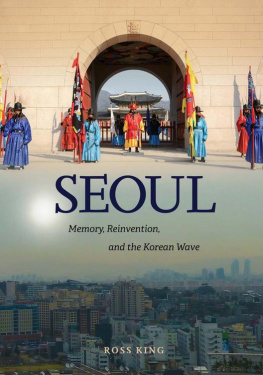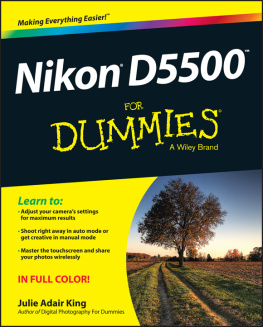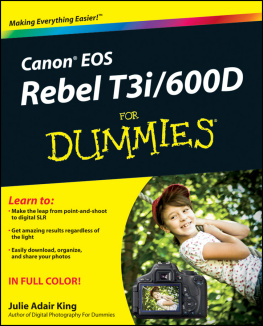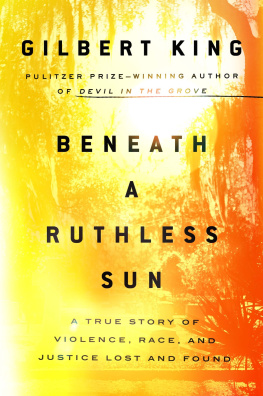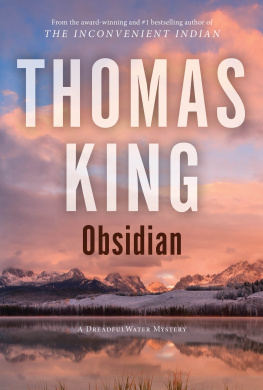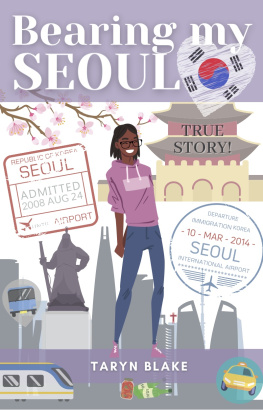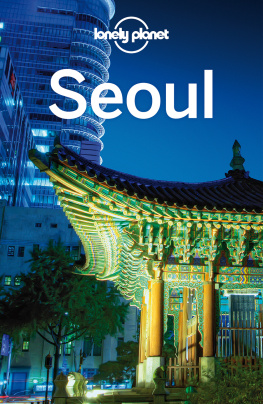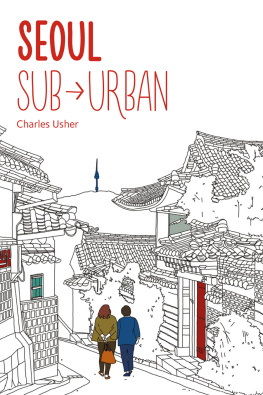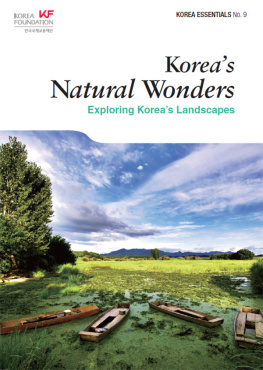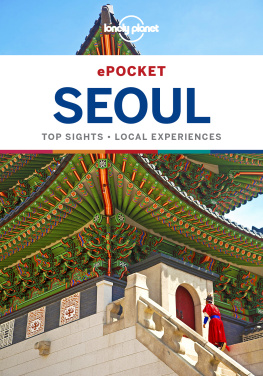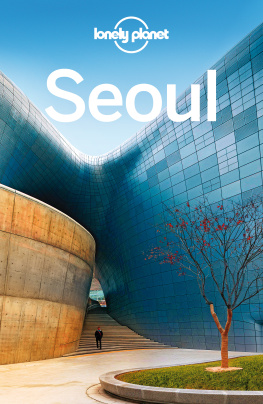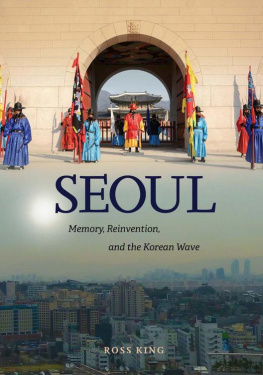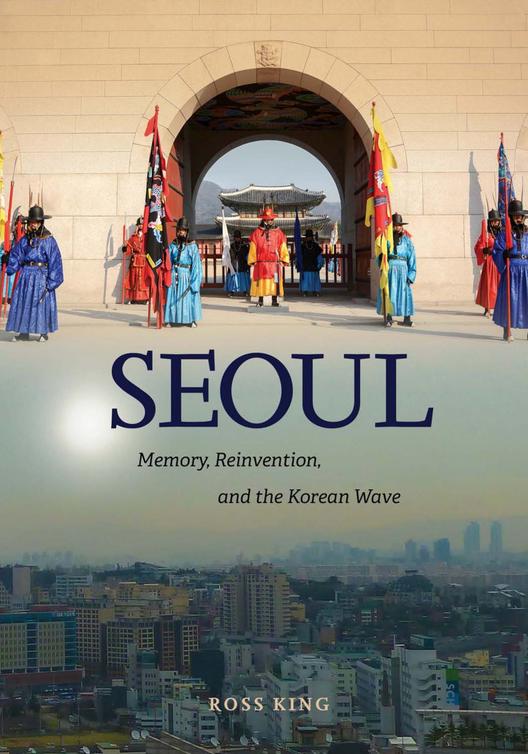2018 University of Hawaii Press
All rights reserved
Printed in the United States of America
23 22 21 20 19 18 6 5 4 3 2 1
Library of Congress Cataloging-in-Publication Data
Names: King, Ross, author.
Title: Seoul : memory, reinvention, and the Korean wave / Ross King.
Description: Honolulu : University of Hawaii Press, [2018] | Includes bibliographical references and index.
Identiers: LCCN 2017036841 | ISBN 9780824872052 (cloth alk. paper), Amazon Kindle 9780824877248, EPUB 9780824877231, PDF 9780824873318
Subjects: LCSH: Seoul (Korea)History. | ArchitectureKorea (South)Seoul.
Classication: LCC DS925.S457 K59 2018 | DDC 951.95dc23
LC record available at https://lccn.loc.gov/2017036841
University of Hawaii Press books are printed on acid-free paper and meet the guidelines for permanence and durability of the Council on Library Resources.
Designed by Mardee Melton
All photos, maps, and drawings are by the author unless otherwise indicated.
In the 1990s ones rst glimpse of Seoul would typically be from the air, circling to the old Gimpo airport. At night this could be decidedly disorienting: overwhelming the usual twinkling display of the nighttime city would be a forest of giant, illuminated red crosses, seemingly on all manner of sites and buildings, in an incomprehensible display of Christian witness. One would have heard of Koreas proliferation of sects; however, the realization that proliferation could so transform the fabric of the city would beggar understanding. A second impression, from the ground and in the light of day, would reveal that these crosses were in the main atop the most nondescript of boxes, most frequently also adorned with a bewildering display of advertisement boards for brands and businesses, from the global to the most local. Seoul presents as a city of boxes: even the National Assembly Building, monument to the Fourth Republic and ultimate symbol of the Sixth Republic, reads as a box that would seem to represent nothing, though here without advertisement boards. A further impression would come with the view from the air by day, also from the highway into the city, from the old Gimpo or the new Incheon airport or almost any point in the city: serried arrays of high-rise apartment towers inserted into a disheveled city of boxes and stretching across immense distances. The entry to the city from the new airport can be exceptionally disorientingit is across seemingly limitless mudflats, alluvial plains, with no clear horizon line, visually bleak and desolate, empty, with distant and disconnected mountains seemingly floating on the mud; there are glimpses of high-rise cities, also disconnected and distanced both from each other and from the traveling observer, presenting as dispersed assemblages of concrete towers. These also arise from a world of mud and motionless water.
Old Seoul is a seemingly disordered city of nondescript boxes; new Seoul presents as a place of regimented, undifferentiated order. It will be argued in what follows that the ambiguity of seemingly opposed urban realms is a consequence of Seouls cultural history, most notably of the obliterations of the twentieth centurycolonialism, war, x decolonization, recolonization in the name of liberation, and then ambivalent revolution in the midst of rampant developmentalism. Korea is the paradigm case of both surviving and reconstructed cultural memory intersecting with the imaginingor is it the reality?of cultural erasure. It is into this ambiguity of perceptions and experiences that there flooded the economic miracle, a fury of creativity and invention in an age of electronic fadism but distorted memories, the explosion of Korean video art and the phenomenon of the Korean Wave in global pop culture. Whereas Benedict Anderson (1991) has argued that print capitalism was an enabling condition for the rise of the classic nation-state, it became necessary to imagine the new, postrevolutionary (post-1987) Korean nation to ll the void of twentieth-century destructions and contested memories in a later age of electronic communication and digital imagery.
The argument to be addressed in this book concerns two sets of dialectical relationships. The rst is between destruction and creativitydisruption, even erasure, as a condition of possibility underlying the explosion of creativity and new invention. It is akin to the argument of creative destruction variously linked to the ideas of Nietzsche, Walter Benjamin, and Joseph Schumpeter. It will be suggested that the imagining of a new form of nation to follow the 1910 Japanese annexation of Korea was always already immanent in the culture and was certainly nding expression by the time of the abortive 1919 anti-Japanese uprising and establishment of the Provisional Government of the Republic of Korea in Shanghai.
The second dialectic is that of the local and the hyperspatial, the stretching of space and time to accommodate the ever-accelerating flows of capital, information, ideas, and desires that characterize the world of late capitalism. It is the space of undifferentiated jetliners and international airports that are ultimately interchangeable despite all efforts at national or city identity; likewise hotel lobbies and shopping malls with their identical sets of franchised outlets marketing identical sets of productsthe same logos, imagery, and automobiles, the Cineplex with the same instant-release movies the world over. It is also the space of the mobile phone, the Internet, Facebook, CNN, BBC World, Al Jazeera. Yet the hyperspace also rests on hypertraditionalismon the exaggeration of the local and its difference as each city competes with all others for global tourists, entrepreneurs, and investors. Places frenetically compete for tourist consumption, expertise, and investment by demonstrating their specialness and, they hope, their uniqueness. Local ambience and its alterity constitute the necessary obverse of the hyperspace. xi
It is not difficult to locate Seoul in this dialectic of the local and the hyperspatial. The global intrusions are here all in place, as in other world cities; additionally, Korean brands are also now global, such as Samsung, LG, and Hyundai. Koreas cultural production has also broken free from the restrictions of nation and language. However, on rst glance, there is something missing in Seoul. It seems all too modern; certainly the erased palaces are being rebuilt, the old rituals restaged, and the production of new antiquity proceeds apace, yet the continuities of history seem more elusive than in other great cities. The pervading, beguiling, physical (architectural, landscapal) sense of difference is more difficult to discern here, although to discern it and reflect upon it is the fundamental task of this book. The tourists are far less evident in Seoul than they are in Beijing, Shanghai, or Tokyo, although this may be illusory, as Seouls tourists are more likely to be from China and increasingly from Japan.

